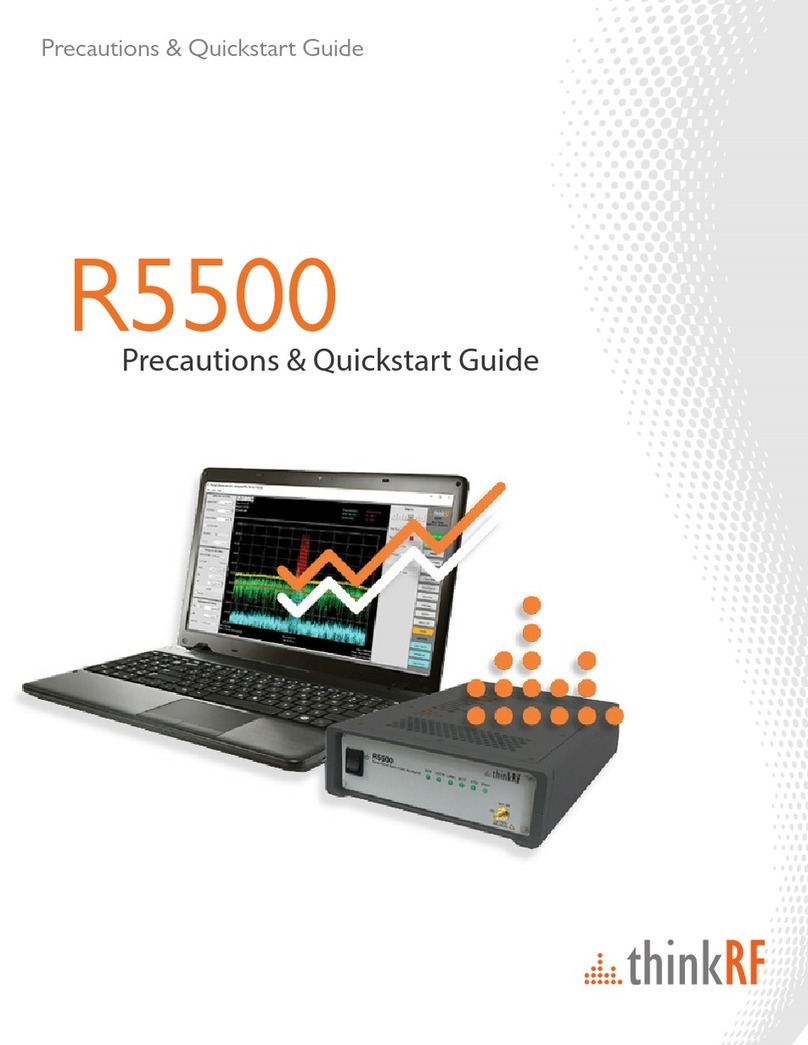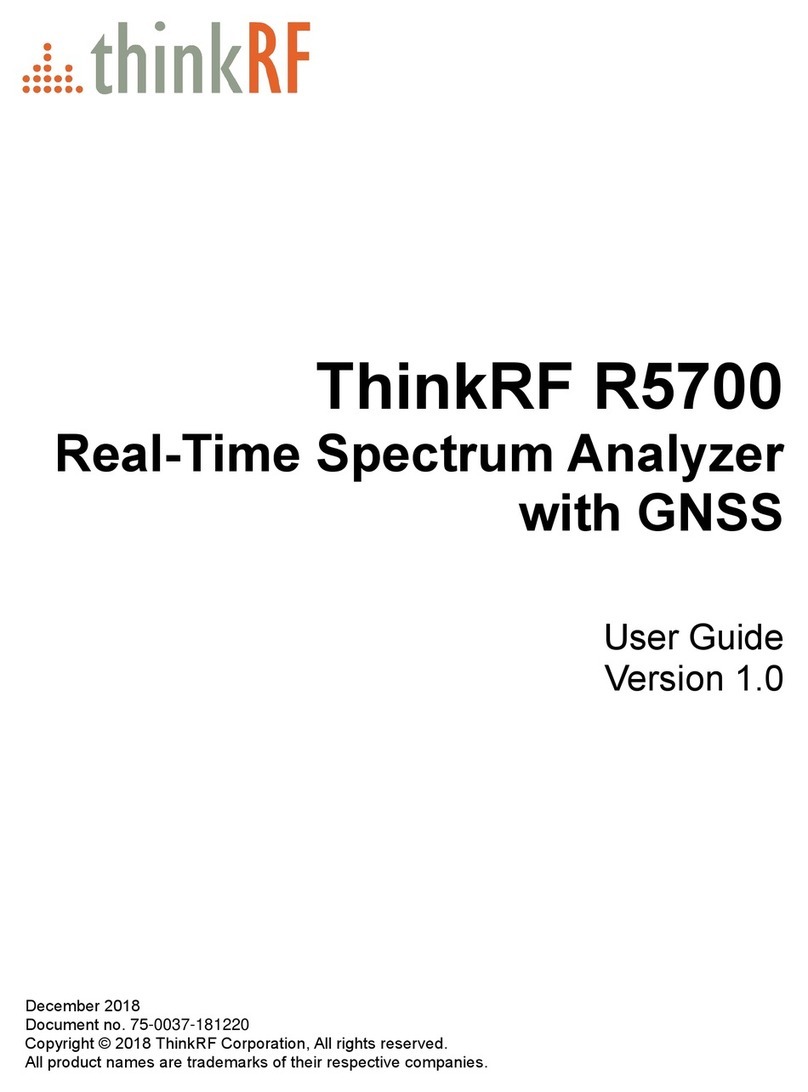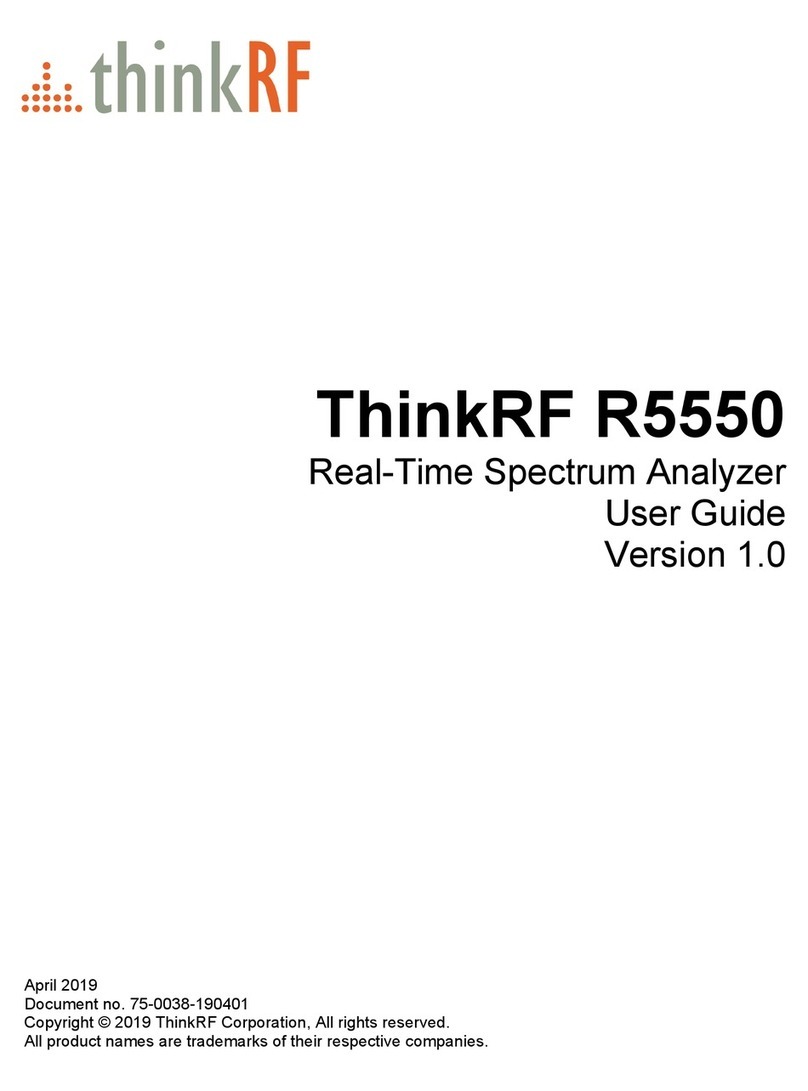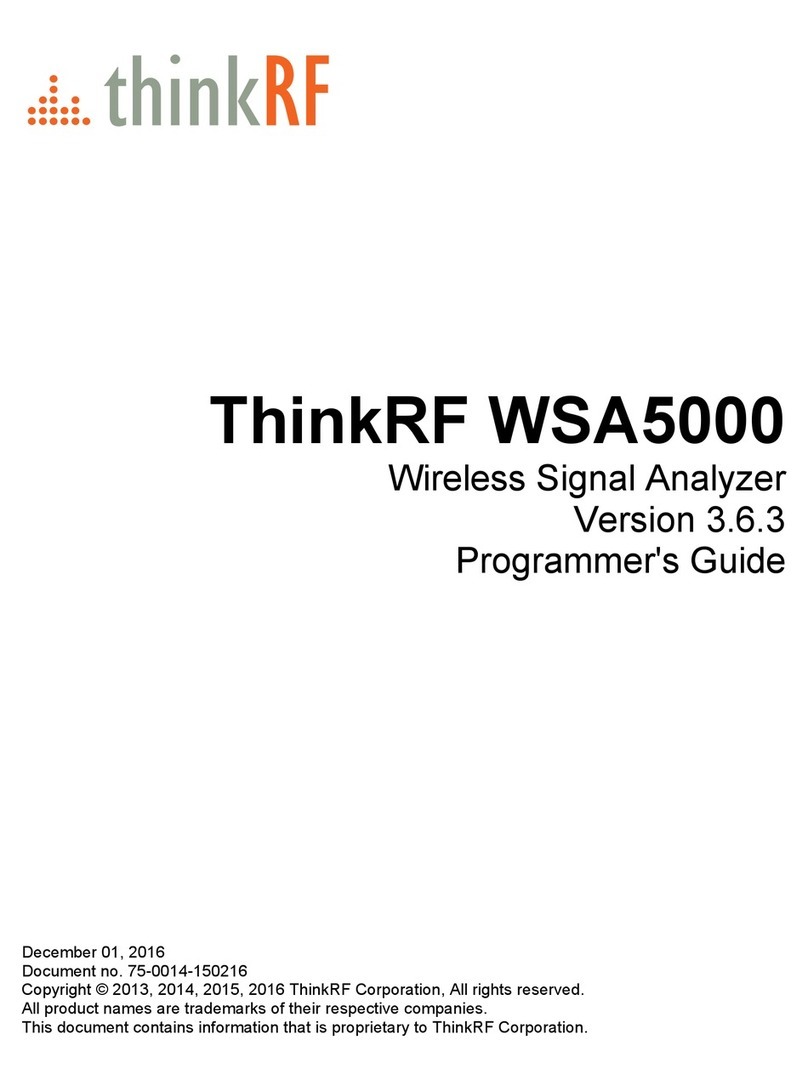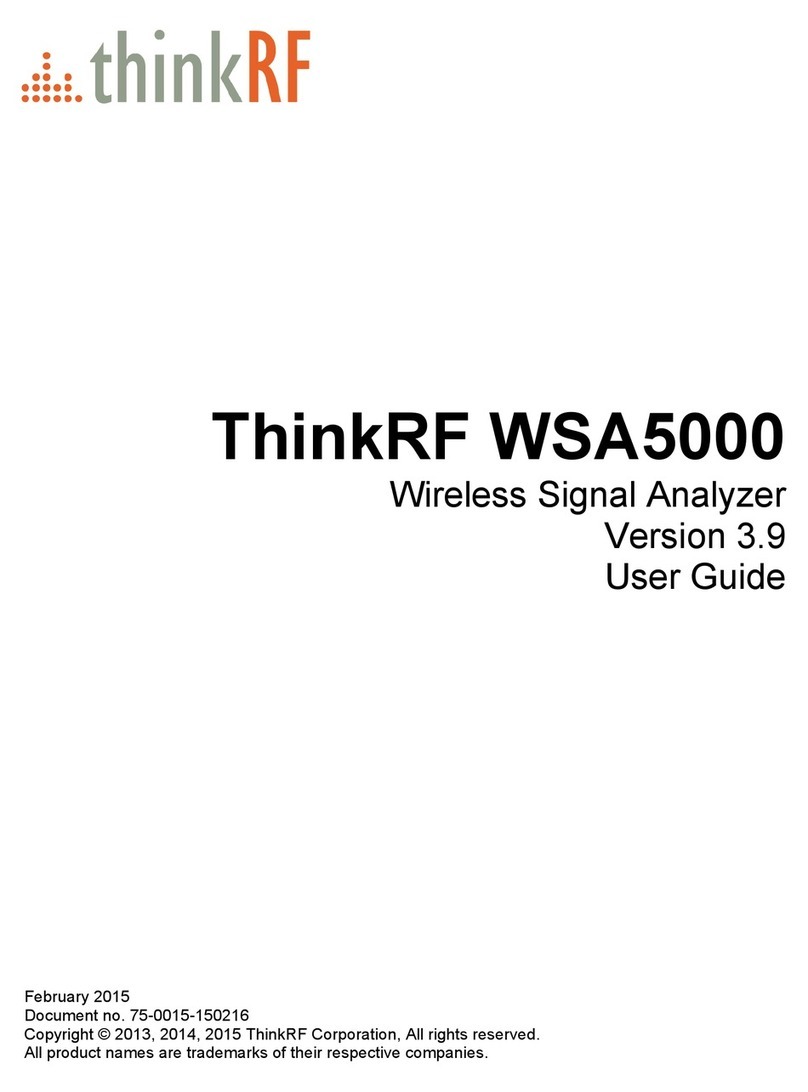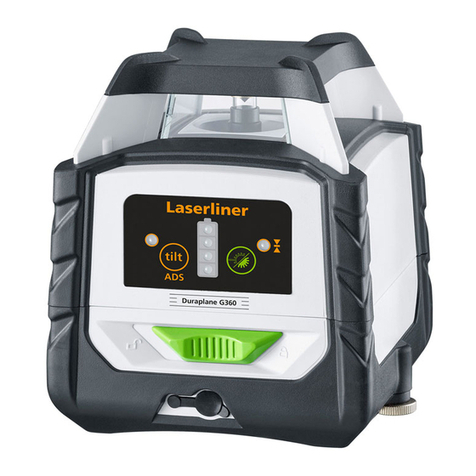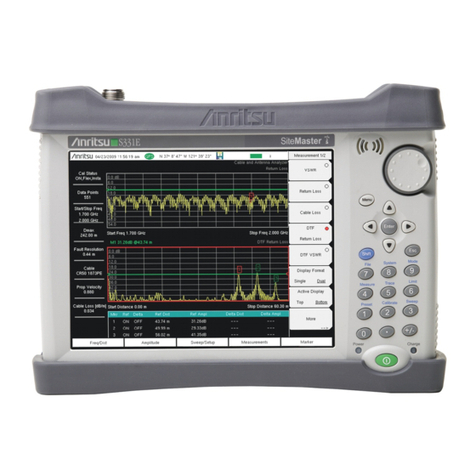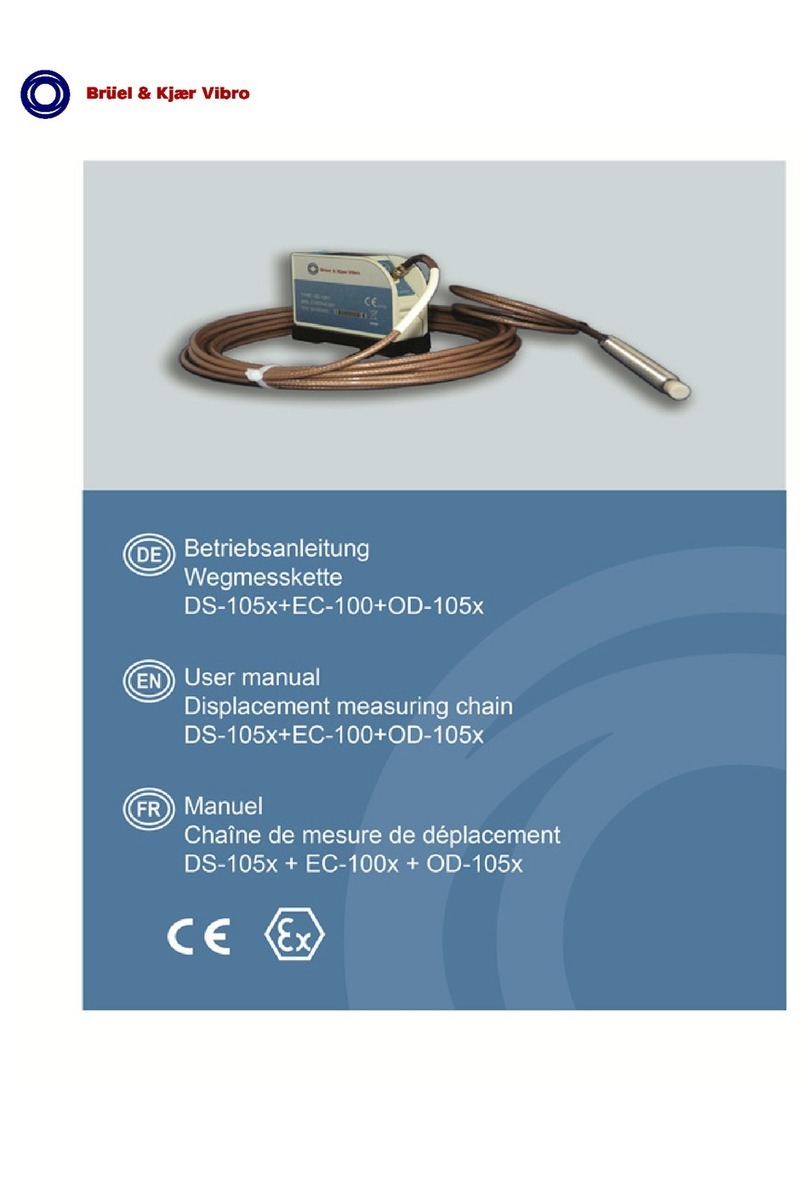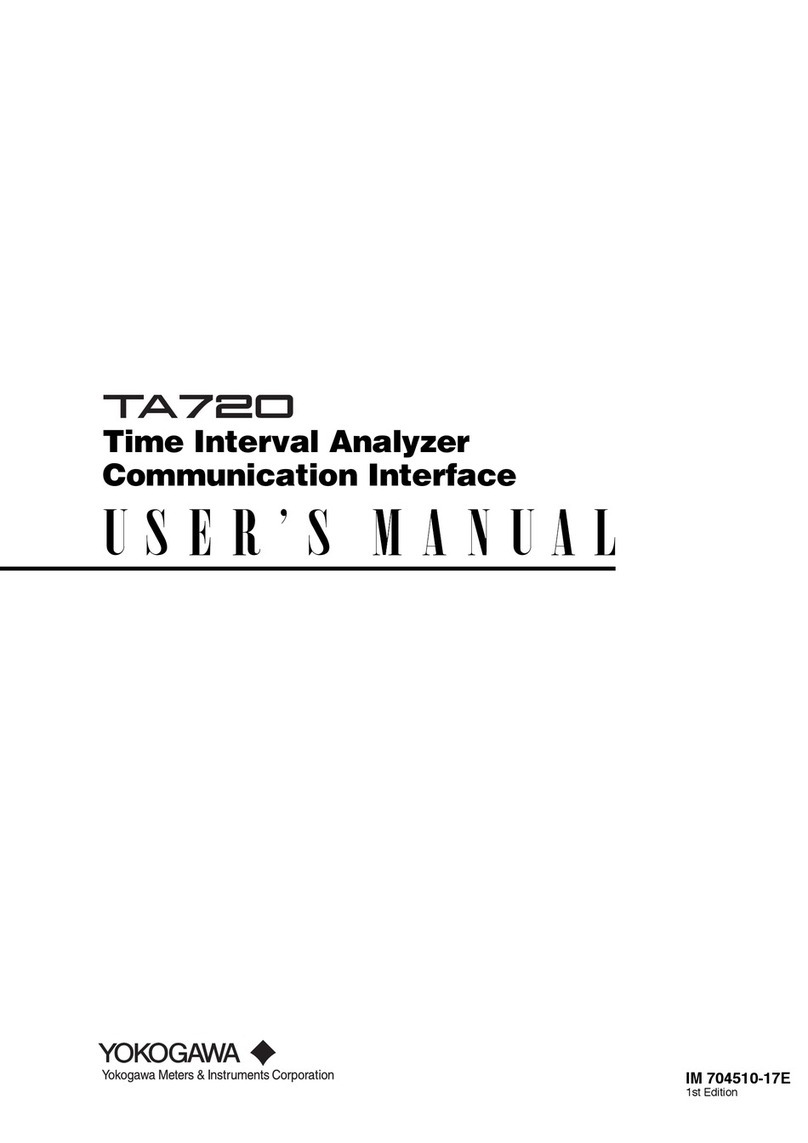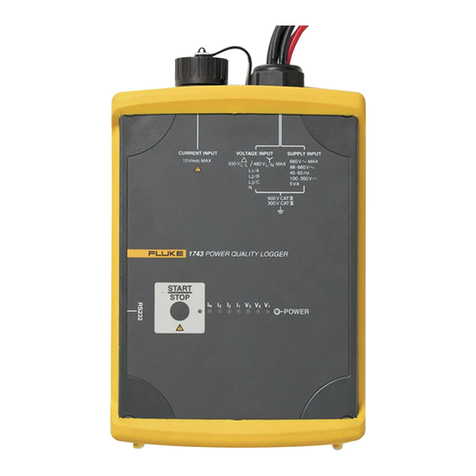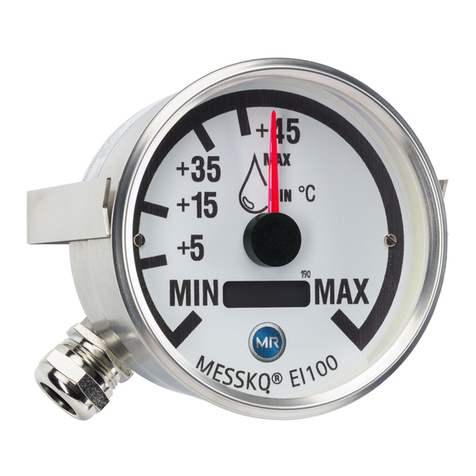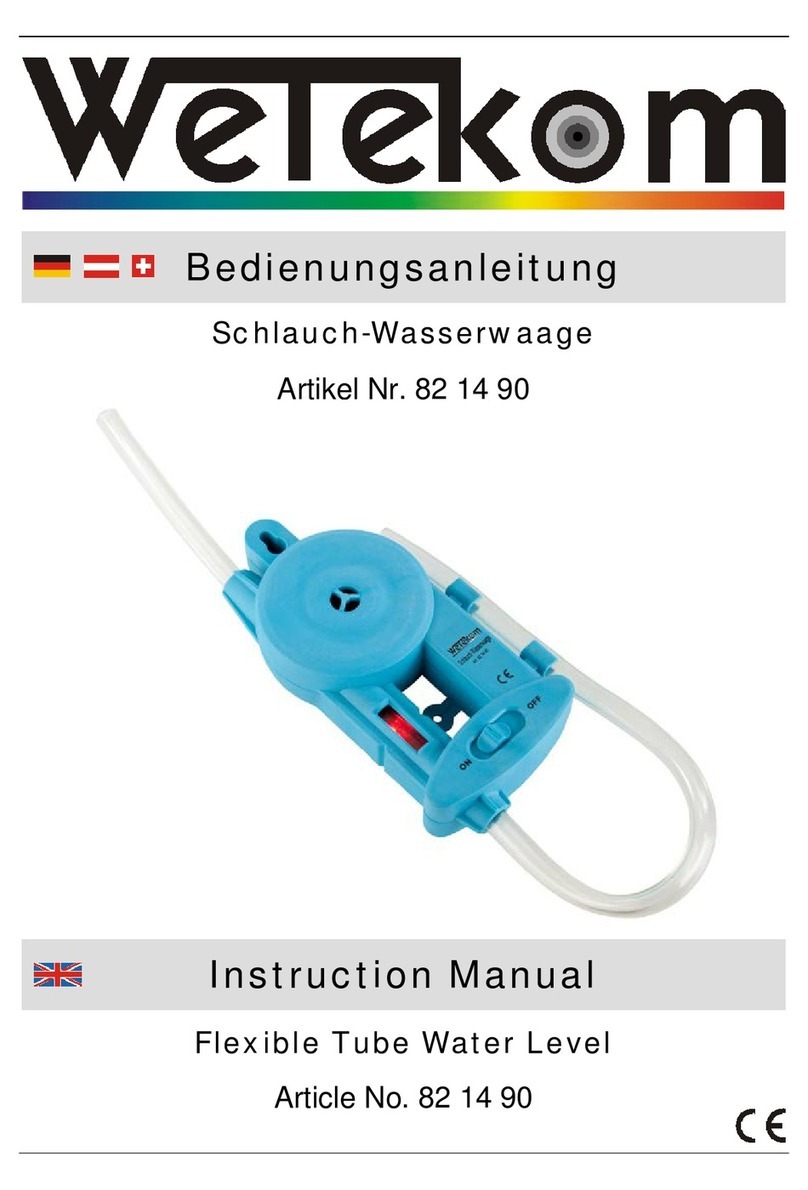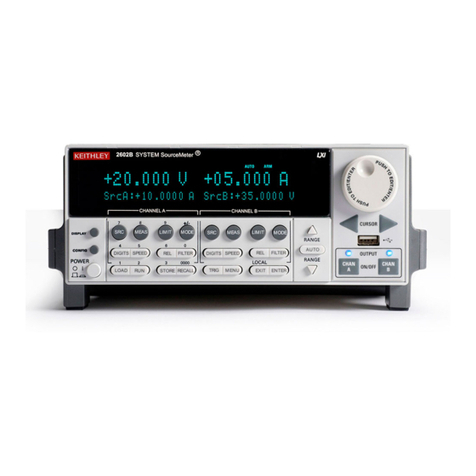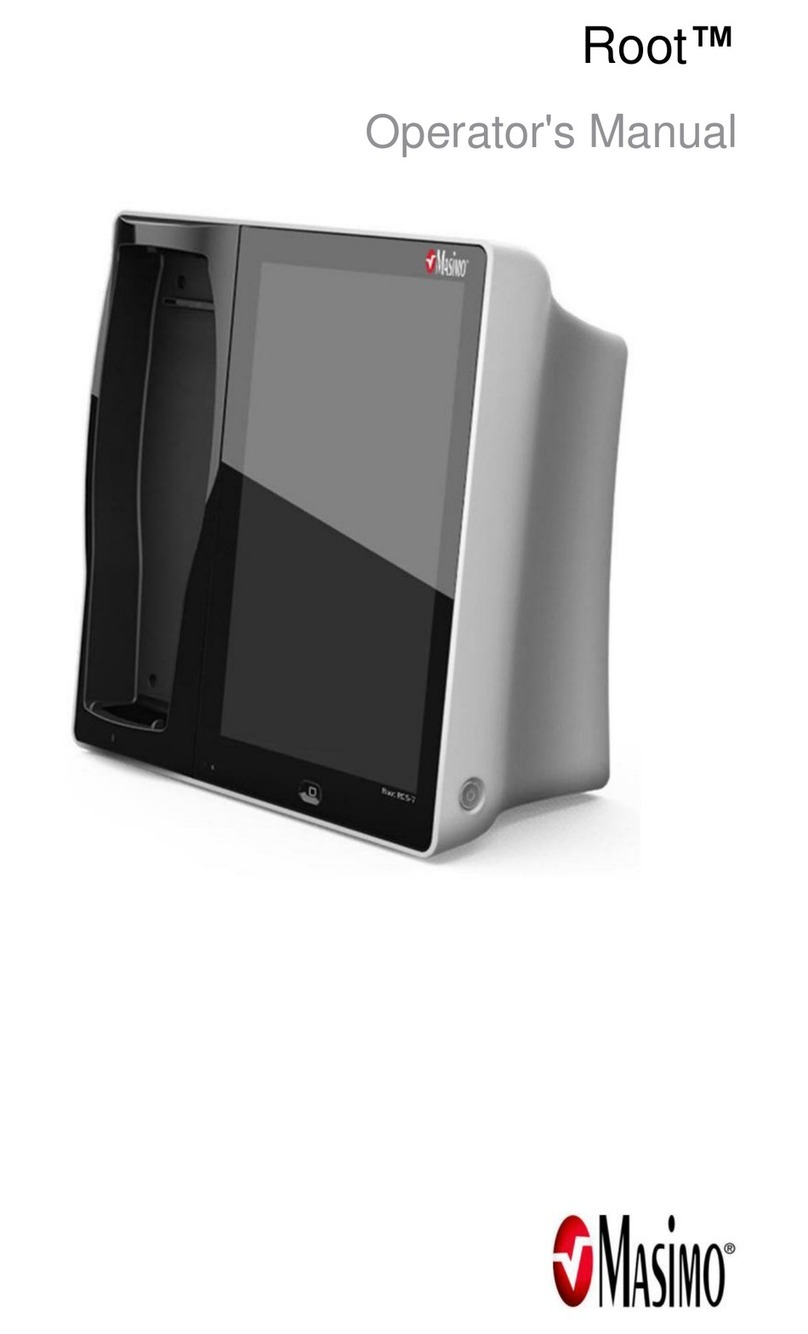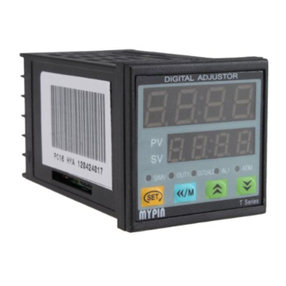ThinkRF R5500 Manual

ThinkRF R5500
Real Time Spectrum Analyzer
Programmer's Guide
Version 4.2.0
August 28 20 7
Document no. 75-0025- 70828
Copyright © 20 3, 20 4, 20 5, 20 6, 20 7 ThinkRF Corporation, all rights reserved.
All product names are trademarks of their respective companies.
This document contains information that is proprietary to ThinkRF Corporation.

Important notice
The information in this
guide is furnished for
informational use only
and is subject to change
without notice. ThinkRF
Corporation assumes no
responsibility or liability
for any errors or
inaccuracies that may
appear in this document.
No part of this
publication may be
reproduced, published,
stored in an electronic
database, or transmitted,
in any form or by any
means, electronic,
mechanical, recording,
or otherwise, for any
purpose, without the
prior written permission
of ThinkRF Corporation.
Trademarks
ThinkRF, the ThinkRF
logo and R5500 are
trademarks of ThinkRF
Corporation.
The following are
trademarks or registered
trademarks of their
respective companies or
owners:
Windows, Windows XP /
Microsoft Corporation
All other brand or
product names are
trademarks or registered
trademarks of their
respective companies or
owners.
ThinkRF Corp
390 March Road
Kanata, ON K2K 0G7
(6 3) 369-5 04
HARDWARE WARRANTY AND LIMITATI N F LIABILITY
Read this warranty carefully before you use the product.
WSA5000 and R5500 Real Time Spectrum Analyzers are warranted for
workmanship and materials for a period of one ( ) year from the date of shipment as
identified by the Customer’s packing slip or carrier waybill. ThinkRF reserves the
right to void the warranty on any equipment that has been altered or damaged due
to Customer negligence, unauthorized repair, misuse of equipment, evidence of
physical or environmental damage, transportation abuse or removal of any ThinkRF
identification labels or serial numbers.
It will remain the responsibility of the Customer, having obtained a Return Material
Authorization (RMA) and shipping instructions from ThinkRF, to return, at the
Customer's expense, the defective unit to ThinkRF’s repair facilities. ThinkRF will
incur shipping charges for the return of warranty repaired equipment. The RMA
number can be secured by calling ThinkRF Customer Service and Support ( -6 3-
369-5 04). If the product does not fall within ThinkRF’s warranty period or the
product is found to be functioning as designed, then under the terms of ThinkRF’s
warranty policy, all costs of repairs and shipping will be charged directly to the
Customer. ThinkRF will warrant repaired units for a period of 90 days from date of
shipment from ThinkRF to the Customer. If the remaining period on the original
hardware warranty is greater than 30 days, then ThinkRF will honor this remaining
warranty period.
THINKRF EXPRESSLY DISCLAIMS ALL OTHER WARRANTIES AND
CONDITIONS, WHETHER EXPRESS OR IMPLIED, INCLUDING WITHOUT
LIMITATION, WARRANTIES, CONDITIONS OR REPRESENTATIONS OF
WORKMANSHIP, MERCHANTABILITY, FITNESS FOR A PARTICULAR
PURPOSE, DURABILITY, OR THAT THE OPERATION OF THE HARDWARE OR
LICENSED SOFTWARE WILL BE ERROR FREE. IN NO EVENT WILL THINKRF
BE LIABLE FOR INDIRECT, SPECIAL, INCIDENTAL, OR CONSEQUENTIAL
DAMAGES.
USE F PR DUCTS IN HIGH RISK ACTIVITIES
THINKRF PRODUCTS ARE INTENDED FOR STANDARD INDOOR COMMERCIAL
USE. WITHOUT THE APPROPRIATE NETWORK DESIGN ENGINEERING, THEY
MUST NOT BE USED FOR ANY “HIGH RISK ACTIVITY”, as described in this
paragraph. Customer acknowledges and agrees that the products supplied
hereunder are not fault-tolerant and are not designed, manufactured or intended for
use or resale as on-line control equipment in hazardous environments requiring fail
safe performance including but not limited to the operation of nuclear facilities,
aircraft navigation or communication systems, air traffic control, direct life support
machines, or weapons systems, in which the failure of products could lead directly to
death, personal injury, or severe physical or environmental damage, all of which are
examples of “High Risk Activity”. THINKRF AND ITS SUPPLIERS EXPRESSLY
DISCLAIM ANY EXPRESS OR IMPLIED WARRANTY OF FITNESS FOR HIGH
RISK ACTIVITIES.
GNU General Public License
This device contains free firmware: you can redistribute it and/or modify it under the
terms of the GNU General Public License as published by the Free Software
Foundation, either version 2 of the License, or (at your option) any later version. This
program is distributed in the hope that it will be useful, but WITHOUT ANY
WARRANTY; without even the implied warranty of MERCHANTABILITY or
FITNESS FOR A PARTICULAR PURPOSE. See the GNU General Public License
for more details. GNU General Public License is available at
http://www.gnu.org/licenses.

Table of Contents
Abbreviations ................................................................................................................................... 7
List of Figures .................................................................................................................................. 8
List of Tables .................................................................................................................................... 9
Preface ............................................................................................................................................... 10
Audience .................................................................................................................................... 10
Conventions .............................................................................................................................. 10
btaining Documentation and Releases ........................................................................... 10
Document Feedback ............................................................................................................... 11
btaining Technical Assistance .......................................................................................... 11
R5500 Functional verview .................................................................................................... 12
System verview ..................................................................................................................... 12
The Architecture ...................................................................................................................... 15
RF Receiver Front-End ........................................................................................................... 16
Direct-Conversion Receiver Technology .............................................................................. 7
DC Offset Correction ...................................................................................................... 7
IQ Offset Correction ........................................................................................................ 7
Digital Signal Processing ...................................................................................................... 19
Digital Down Converter ......................................................................................................... 9
Triggers ...................................................................................................................................... 20
Frequency Domain Triggering .............................................................................................. 20
Periodic Triggering ................................................................................................................ 2
External Triggering ............................................................................................................... 2
Capture Controller ................................................................................................................... 22
Trace Capture Control .......................................................................................................... 22
Sweep Capture Control ........................................................................................................ 23
Synchronized Sweep ............................................................................................................ 24
VITA-49 Radio Transport Protocol ...................................................................................... 26
Purpose ...................................................................................................................................... 26
R5500's VRT verview ........................................................................................................... 26
Packet Classes and Streams ................................................................................................ 27
Receiver Context Packet Class ............................................................................................ 27
Context Field Change Indicator ...................................................................................... 29
RF Reference Frequency ............................................................................................... 29
Gain ................................................................................................................................ 29
Temperature ................................................................................................................... 29
Digitizer Context Packet Class ............................................................................................. 30
Context Field Change Indicator ...................................................................................... 3
Bandwidth ....................................................................................................................... 3
Reference Level ............................................................................................................. 3
RF Frequency Offset ...................................................................................................... 32
Extension Context Packet Class ........................................................................................... 32
Context Field Change Indicator ...................................................................................... 34

IQ Swapped Indicator ..................................................................................................... 34
New Stream Start ID ....................................................................................................... 34
New Sweep Start ID ....................................................................................................... 34
IF Data Packet Class ............................................................................................................ 34
Picosecond Timestamp Words Format ........................................................................... 36
Data Payload Format ...................................................................................................... 36
Trailer Word Format ....................................................................................................... 37
SCPI Command Set ..................................................................................................................... 40
SCPI Language verview ...................................................................................................... 40
IEEE Mandated SCPI Commands ........................................................................................ 41
*CLS ..................................................................................................................................... 4
*ESE/*ESE? ......................................................................................................................... 4
*ESR? ................................................................................................................................... 42
*IDN? .................................................................................................................................... 42
*OPC/*OPC? ........................................................................................................................ 42
*RST ..................................................................................................................................... 42
*SRE/*SRE? ......................................................................................................................... 43
*STB? ................................................................................................................................... 43
*TST? ................................................................................................................................... 43
*WAI ..................................................................................................................................... 44
SYSTem Commands ............................................................................................................... 44
:SYSTem:ABORt .................................................................................................................. 44
:SYSTem:CAPTure:MODE? ................................................................................................. 44
:SYSTem:COMMunicate:LAN:APPLy ................................................................................... 44
:SYSTem:COMMunicate:LAN:CONFigure ........................................................................... 45
:SYSTem:COMMunicate:LAN:DNS ...................................................................................... 45
:SYSTem:COMMunicate:LAN:GATEway ............................................................................. 46
:SYSTem:COMMunicate:LAN:IP .......................................................................................... 46
:SYSTem:COMMunicate:LAN:NETMask .............................................................................. 47
:SYSTem:COMMunicate:NTP .............................................................................................. 47
:SYSTem:ERRor[:NEXT]? .................................................................................................... 48
:SYSTem:ERRor:ALL? ......................................................................................................... 48
:SYSTem:FLUSh .................................................................................................................. 48
:SYSTem:LOCK:HAVE? ....................................................................................................... 49
:SYSTem:LOCK:REQuest? .................................................................................................. 49
:SYSTem:OPTions? ............................................................................................................. 50
:SYSTem:SYNC:MASTer ..................................................................................................... 50
:SYSTem:SYNC:WAIT ......................................................................................................... 5
:SYSTem:VERSion? ............................................................................................................. 5
:SYSTem:DATE .................................................................................................................... 5
:SYSTem:TIME ..................................................................................................................... 52
:SYSTem:TIME:ADJust ........................................................................................................ 52
:SYSTem:TIME:SYNC .......................................................................................................... 52
:SYSTem:TIME:SYNC:STATus? .......................................................................................... 53
STATus Commands ................................................................................................................ 54
:STATus:OPERation[:EVENt]? ............................................................................................. 55
:STATus:OPERation:CONDition? ......................................................................................... 55
:STATus:OPERation:ENABle ............................................................................................... 56
:STATus:PRESET ................................................................................................................ 56
:STATus:QUEStionable[:EVENt]? ........................................................................................ 56
:STATus:QUEStionable:CONDition? .................................................................................... 56
:STATus:QUEStionable:ENABle .......................................................................................... 57
:STATus:TEMPerature? ....................................................................................................... 57
INPut Commands ..................................................................................................................... 58

:INPut:ATTenuator ................................................................................................................ 58
:INPut:ATTenuator:VARiable ................................................................................................ 58
:INPut:GAIN .......................................................................................................................... 58
:INPut:GAIN:HDR ................................................................................................................. 59
:INPut:MODE ........................................................................................................................ 60
S URce Commands ............................................................................................................... 60
:SOURce:REFerence:PLL .................................................................................................... 60
:SOURce:REFerence:PLL:RESET ....................................................................................... 6
SENSe Commands .................................................................................................................. 61
[:SENSe]:DECimation ........................................................................................................... 6
[:SENSe]:FREQuency:CENTer ............................................................................................ 62
[:SENSe]:FREQuency:IF? .................................................................................................... 62
[:SENSe]:FREQuency:INVersion? ........................................................................................ 63
[:SENSe]:FREQuency:LOSCillator? ..................................................................................... 63
[:SENSe]:FREQuency:SHIFt ................................................................................................ 64
[:SENSe]:LOCK:REFerence? ............................................................................................... 64
[:SENSe]:LOCK:RF? ............................................................................................................ 65
UTput Commands ................................................................................................................ 65
:OUTput:MODE .................................................................................................................... 65
TRIGger Commands ............................................................................................................... 66
:TRIGger:TYPE .................................................................................................................... 66
:TRIGger:LEVel .................................................................................................................... 66
:TRIGger:PERiodic ............................................................................................................... 67
TRACe Commands .................................................................................................................. 67
:TRACe:BLOCk:DATA? ........................................................................................................ 68
:TRACe:BLOCk:PACKets ..................................................................................................... 69
:TRACe:SPPacket ................................................................................................................ 69
:TRACe:STReam:STARt ...................................................................................................... 70
:TRACe:STReam:STOP ....................................................................................................... 7
SWEep Commands ................................................................................................................. 71
:SWEep:LIST:ITERations ..................................................................................................... 72
:SWEep:LIST:STARt ............................................................................................................ 72
:SWEep:LIST:STATus? ........................................................................................................ 73
:SWEep:LIST:STOP ............................................................................................................. 73
:SWEep:ENTRy:COPY ......................................................................................................... 73
:SWEep:ENTRy:COUNt? ..................................................................................................... 74
:SWEep:ENTRy:DELETE ..................................................................................................... 74
:SWEep:ENTRy:NEW ........................................................................................................... 74
:SWEep:ENTRy:READ? ....................................................................................................... 75
:SWEep:ENTRy:SAVE ......................................................................................................... 75
:SWEep:ENTRy:ATTenuator ................................................................................................ 75
:SWEep:ENTRy:ATTenuator:VARiable ................................................................................ 76
:SWEep:ENTRy:DECimation ................................................................................................ 76
:SWEep:ENTRy:FREQuency:CENTer .................................................................................. 76
:SWEep:ENTRy:FREQuency:STEP ..................................................................................... 76
:SWEep:ENTRy:FREQuency:SHIFt ..................................................................................... 77
:SWEep:ENTRy:GAIN:HDR ................................................................................................. 77
:SWEep:ENTRy:MODE ........................................................................................................ 77
:SWEep:ENTRy:DWELl ........................................................................................................ 77
:SWEep:ENTRy:PPBlock ..................................................................................................... 78
:SWEep:ENTRy:SPPacket ................................................................................................... 78
:SWEep:ENTRy:TRIGger:LEVel ........................................................................................... 78
:SWEep:ENTRy:TRIGger:TYPE ........................................................................................... 78
Appendix A: Connecting to RTSA ..................................................................................... 79

Appendix B: Protocol for Discovering RTSA .............................................................. 80
Appendix C: SCPI Command Syntax ............................................................................... 81
Entering Commands ............................................................................................................... 81
Notation ..................................................................................................................................... 82
Parameter types ....................................................................................................................... 82
Default Units ............................................................................................................................. 83
Appendix D: SCPI Status and Event Registers .......................................................... 84
Status Byte Register (SBR) ................................................................................................... 84
Standard Event Status Register (ESR) ............................................................................... 84
perational Status ( SR) Register ..................................................................................... 85
utput Queue ........................................................................................................................... 85
Error and Event Queue ........................................................................................................... 85
Appendix E: SCPI Error Codes Used ............................................................................... 86
Appendix F: SCPI Commands Quick Reference ....................................................... 87
WSA5000 vs. R5500 List of Changes ................................................................................ 92
References ....................................................................................................................................... 93
Document Revision History ................................................................................................... 94

Abbreviations
ADC Analog-to-Digital Converter
API Application Programming Interface
CIC Cascaded Integrator-Comb
DC Direct Current
DD Direct Digitizer
DDC Digital Down Converter
DDS Direct Digital Synthesizer
DSP Digital Signal Processing
FFT Fast Fourier Transform
FIR Finite Impulse Response
FPGA Field-Programmable Gate Array
GPI General Purpose Input/Output
HDR High Dynamic Range
HIF High Intermediate Frequency
IBW Instantaneous Bandwidth
IEEE Institute of Electrical and Electronics Engineers
IF Intermediate Frequency
IQ In-phase and Quadrature
LAN Local Area Network
MB Mega-Bytes
MSB Most Significant Byte
MSa Mega-Samples
NB Narrowband
NC Numerically Controlled Oscillator
PLL Phase-Locked Loop
RF Radio Frequency
RFE Receiver Front-End
RTSA Real Time Spectrum Analyzer
Sa/s Samples-per-Second
SCPI Standard Commands for Programmable Instruments
SH Super-Heterodyne
SHN Super-Heterodyne with narrower bandwidth
TCP/IP Transmission Control Protocol/Internet Protocol
TD Time Domain
TSF TimeStamp-Fractional
TSI TimeStamp-Integer
TSM TimeStamp Mode
UTC Coordinated Universal Time
VC Voltage Control Oscillator
VRT VITA-49 Radio Transport
WB Wideband
ZIF Zero Intermediate Frequency

List of Figures
Figure : R5500 Functional Block Diagram ............................................................................................ 3
Figure 2: RF Receiver Front-end and Capture Controller Functional Block Diagram .............................. 5
Figure 3: DC Offset with Amplitude Roll-Off at +50MHz ......................................................................... 7
Figure 4: IQ Offset Correction ................................................................................................................. 8
Figure 5: DDC Functional Block Diagram ............................................................................................... 9
Figure 6: Association between Time and Frequency Domain ................................................................. 2
Figure 7: Synchronized Sweep using Sync-Word ................................................................................... 25
Figure 8: Synchronized Sweep with a Missed Capture ........................................................................... 25
Figure 9: Connectivity and 4 Different Packet Streams Supported by R5500 ......................................... 26
Figure 0: An Example Illustrating Uninverted and Inverted Spectrums ................................................. 39
Figure : SCPI Language Hierarchical or Tree Structure Example ....................................................... 40
Figure 2: SCPI Measurement Function Block ....................................................................................... 4
Figure 3: Status Reporting Structure with Status & Enable Registers ................................................... 54

List of Tables
Table : System Level Control/Status Commands .................................................................................. 3
Table 2: Radio RFE Modes and DSP Data Output Formats ................................................................... 6
Table 3: RF Front-End Control/Status Commands ................................................................................. 8
Table 4: Trigger Control/Status Commands ............................................................................................ 2
Table 5: Trace Capture Control Commands ........................................................................................... 22
Table 6: Sweep Capture Control/Status Interface ................................................................................... 23
Table 7: The Categories of VRT Packet Streams Supported by ThinkRF's R5500 ................................ 26
Table 8: A List of Stream Identifiers As Used by ThinkRF for Different Packet Classes ......................... 27
Table 9: Receiver Context Packet Class Structure ................................................................................. 28
Table 0: Receiver Context Indicator Field Positions .............................................................................. 28
Table : Receiver Context Field Definition and Values ......................................................................... 28
Table 2: RF Reference Frequency Word Format .................................................................................. 29
Table 3: Gain Field Format ................................................................................................................... 29
Table 4: Temperature Field Format ...................................................................................................... 29
Table 5: Digitizer Context Packet Class Structure ................................................................................ 30
Table 6: Digitizer Context Indicator Field Bit Positions .......................................................................... 30
Table 7: Digitizer Context Field Values ................................................................................................. 3
Table 8: Bandwidth Word Format ......................................................................................................... 3
Table 9: Reference Level Field Format ................................................................................................. 32
Table 20: RF Frequency Offset Word Format ......................................................................................... 32
Table 2 : Extension Context Packet Class Structure .............................................................................. 33
Table 22: Extension Context Indicator Field Positions ............................................................................ 33
Table 23: Receiver Context Field Definition and Values ......................................................................... 33
Table 24: New Stream Start ID Field Format .......................................................................................... 34
Table 25: New Sweep Start ID Field Format ........................................................................................... 34
Table 26: Output Data Width and Packing Method for Different Data Formats ....................................... 35
Table 27: IF Data Class Field Values ...................................................................................................... 35
Table 28: Stream Identifier Values for Different Data Output Formats .................................................... 35
Table 29: 64-bit or Two Words Picosecond Timestamp Format ............................................................. 36
Table 30: {I 4Q 4} Data Payload Arrangement with Upper 2-bit of Each Item Signed Extended to {I 6
Q 6} ........................................................................................................................................ 36
Table 3 : {I 4} Data Payload Arrangement with Upper 2-bit Signed Extended to {I 6} .......................... 37
Table 32: {I24} Data Payload Arrangement with Upper 8-bit Signed Extended to {I32} .......................... 37
Table 33: Trailer Word Format ................................................................................................................ 37
Table 34: Trailer Indicator and Enable Bits ............................................................................................. 38
Table 35: Conditions Causing Abnormal Indicator State and Suggested Resolution .............................. 39
Table 36: RTSA Option Codes and the Corresponding Description ....................................................... 50
Table 37: Performance of The Gain Settings of R5500-4 8, 427 and Their Variants ............................. 59
Table 38: Maximum Threshold Level Where +/-3 dBm Error or Less Still Hold For A Given Attenuation
Level ....................................................................................................................................... 67
Table 39: Max, Min, and Required Multiples for SPP and Samples-per-word for Different Data Output
Format .................................................................................................................................... 70

Preface
This preface describes the audience for, the organization of, and conventions used in this
document. It also identifies related documentation and explains how to access electronic
documentation.
Audience
This document is written for software developers wishing to develop and/or maintain a
software interface to the R5500 and who have a basic understanding, familiarity and
experience with network test and measurement equipment.
Conventions
This section describes the conventions used in this document.
Grayed-out Font
Indicates a command or a feature is not yet available in the current release.
Courier Font
Illustrates this is an example for a command or a concept.
Light Blue Font
Contains hyperlink to the referenced source that can be clicked on.
Normal Bold Font
When used within a sentence or a paragraph, it emphasizes an idea to be paid attention
to particularly.
Red Font
Conveys special information of that section.
Note: This symbol means take note. Notes contain helpful suggestions or references to
additional information and material.
Caution: This symbol means be careful. In this situation, you might do something that
could result in equipment damage or loss of data.
Warning: This symbol means danger. You are in a situation that could cause bodily
injury. Before you work on any equipment, be aware of the hazards involved with
electrical circuitry and be familiar with the standard practices for preventing accidents.
btaining Documentation and Releases
You can access the most current ThinkRF documentation and the latest release bundles
at http://www.thinkrf.com/resources.

Document Feedback
Please send your comments about this document or our other documentation to
Thank you, we appreciate your comments.
btaining Technical Assistance
The ThinkRF Support website provides online documents for resolving technical issues
with ThinkRF products at http://www.thinkrf.com/resources.
For all customers who hold a valid end-user license, ThinkRF provides technical
assistance 9 AM to 5 PM Eastern Time, Monday to Friday. Contact us at
[email protected] or by calling +1.613.369.5104.
Before contacting Support, please have the following information available:
•R5500's serial number and product version, which are located on the identification
label on the R5500's underside.
•The firmware version running on the R5500.
•Versions of ThinkRF software you are using, potentially including the S240, API
libraries to third-party applications.
•The operating system and version you are using.

R5500 Functional verview
R5500 Functional verview
This section overviews the R5500's functionality and protocols used, and summarizes the
SCPI command sets for controlling the individual functions.
Note: This is a living and evolving document. We welcome your feedback.
The features and functionality described in this section may exist in the current product
firmware release or are scheduled for a future product firmware release (grayed out
commands and/or text). Please refer to Appendix F: SCPI Commands Quick Reference
for the complete list of commands and the availability information. No hardware upgrade
is required at each feature release (unless specified though unlikely).
System verview
The R5500 Real Time Spectrum Analyzer (RTSA) is a high-performance software-
defined RF receiver, digitizer and analyzer, as illustrated in Figure . With patent-
pending software-defined RF receiver technology, the RTSA provides industry leading
combined sensitivity, tuning range, instantaneous bandwidth (IBW) and scan rate.
Additionally, it provides real-time sophisticated triggering and capture control.
The R5500 is designed for stand-alone, remote and/or distributed wireless signal
analysis. It is ideal for monitoring, management and surveillance of transmitters, whether
they are in-building or spread across a geographic area. Applications include, but are not
limited to:
•5G wireless technology;
•research;
•test and measurement;
•monitoring;
•OEM integration.
The R5500 hardware largely consists of:
•a hybrid super-heterodyne, direct-conversion and direct-digitization RF receiver
front-end (RFE);
•receiver front end inputs and outputs to support clock synchronization, and IF
outputs for high-end digitization;
•a 25 MSample/sec 4-bit wideband (WB) ADC with a dynamic range of greater
than 70 dB;
•a 300 kSample/sec 24-bit narrowband (NB) ADC with a dynamic range in excess of
00dB;
•a Xilinx's Zynq FPGA with built-in dual-core ARM®-based processor, Gigabit
Ethernet interface and custom embedded digital signal processing (DSP) logic;
• GB of DDR3 shared between firmware and real-time caching of digitized data;
•a general purpose input/output (GPIO) port.
ThinkRF R5500 Real Time Spectrum Analyzer Programmer's Guide 12

R5500 Functional verview
Figure 1: R5500 Functional Block Diagram
ThinkRF's products conform with standardized protocols for interoperability. ThinkRF
provides application programming interfaces (APIs) designed for easy integration with
third-party applications. Standard protocols include the Standard Commands for
Programmable Instruments (SCPI) protocol for controlling and obtaining status from the
RTSA and the VITA-49 Radio Transport (VRT) protocol for digitized data and its
associated context information.
In addition, API libraries, written in C/C++, Python, MATLAB and NI LabVIEW, are
provided for quick interfacing, data acquisition and as well as for spectral analysis with
MATLAB® applications. The Python API is built within the PyRF development framework
and is open-source under BSD licensing. PyRF handles the low-level details of real-time
acquisition, signal processing and visualization, and provides feature rich libraries,
example applications and source code, all specific to the requirements of signal analysis.
Usage examples are provided through the available source codes of the Graphical User
Interfaces (GUI) or any applications included in each release package.
Refer to Appendix A for how to connect to a RTSA and Appendix B for the protocol on
how to find any RTSAs available on the local network. The source code provided for the
aforementioned APIs and GUIs/applications would serve as examples.
The R5500 provides system level control and status commands as defined in Table .
Table 1: System Level Control/Status Commands
SCPI Command Description
:SYSTem Page 44
:ABORt Aborts the current data capturing process and puts the RTSA system into
a normal manual mode (i.e. sweep, trigger, and streaming will be aborted)
:CAPTure
13 ThinkRF R5500 Real Time Spectrum Analyzer Programmer's Guide

R5500 Functional verview
SCPI Command Description
:MODE? Gets the current capture mode of the RTSA (i.e. sweeping, streaming or
block mode)
:COMMunicate
:LAN<commands> Subset of commands for configuring/querying RTSA's LAN settings
:ERRor Returns the error code and messages from the SCPI error/event queue
[:NEXT]?
:ALL?
:FLUSh Clears the R5500's internal data storage buffer of any remaining data that
has not transferred out of the RTSA
:LOCK
:HAVE? Returns the current lock state of the task specified
:REQuest? Requests the R5500 to provide a lock on a specific task such that only the
application that has the lock can perform the task
:OPTions? Returns comma separated 3-digit values to represent the hardware
option(s) or features available with a particular RTSA model
:SYNC
:MASTer[?] Sets a RTSA unit to be the master or slave for a synchronization trigger
system with multiple units. Affects :TRIGger:TYPE PULSe or WORD.
:WAIT[?] Sets the delay time in nanoseconds that the system must wait after
receiving the trigger signal before performing data capture
:VERSion? Returns the SCPI version number that the instrument complies with
:DATE[?] Sets/reads date
:TIME[?] Sets/reads time
:ADJust Adjust the system time relative to it's current time
:SYNC[?] Sets/ gets the System time synchronization source via network or SCPI,
or disable
:STATus? Status of the time synchronization
:STATus Page 55
:OPERation Returns the standard Operation Status Register (OSR) for any event
[:EVENt]?
:CONDition?
:ENABle[?]
:PRESET Presets the R5500 (similar to *RST)
:QUEStionable Returns the standard Questionable Status Register (QSR) for any event
[:EVENt]?
:CONDition?
:ENABle[?]
:TEMPerature? Returns the R5500's internal ambient temperature
See SCPI Command Set section (page 40 onward) for further details on the commands.
Caution pertaining to multi-user: The current firmware version of the R5500 allows
multiple applications to connect to the unit simultaneously but it does not support
ThinkRF R5500 Real Time Spectrum Analyzer Programmer's Guide 14

R5500 Functional verview
independent sessions. Therefore, the actions of one user may over-write those of
another. This could potentially damage the unit for instance if the front-end's gain were
incorrectly set. If multiple applications are connecting to the unit, it is advised that only
one of those is controlling the unit at any time.
The Architecture
The R5500 is an integrated wireless radio receiver and digitizer/analyzer. It has an
embedded capture controller that enables users to:
•define and execute real-time and sophisticated triggers, traces and sweeps;
•configure the radio RFE and DSP in association with those traces or sweeps; and
•time-stamping and data output for captures.
Traces and sweeps are controlled by the capture controller as illustrated in the upper
portion of Figure 2. A trace and a sweep are defined as a single (block or continuously
streamed) capture and a series of captures, respectively, each with their associated
hardware configurations.
Figure 2: RF Receiver Front-end and Capture Controller Functional Block Diagram
The R5500 supports different RFE modes of operation and subsequent DSP capabilities
as per Table 2 and as described in the following subsections.
15 ThinkRF R5500 Real Time Spectrum Analyzer Programmer's Guide

R5500 Functional verview
Table 2: Radio RFE Modes and DSP Data Output Formats
Mode1Description Freq Range
(MHz)
IBW
(MHz)
DSP Data utput Format
None CIC/Dec Frequency Shift
ZIF Zero-IF Receiver 50 - max 00 I 4 Q 4 I4 Q 4 I4 Q 4
SH Super-Heterodyne
Receiver
50 - max 40 I 4 I4 Q 42I4 Q 4
SHN SH Receiver with
narrower BW
50 - max 0 I 4 I4 Q 42I4 Q 4
HDR High Dynamic Range
Receiver
50 - max 0. I24 - -
DD Direct Digitization
Receiver
0. - 50350 I 4 I4 I4 Q 4
HIF High IF Receiver 50 - max -- – – –
The RFE Mode availability is product dependent.
2 For SH and SHN modes, when the decimation is used, a frequency shift of 35MHz for non-WBIQ
models will be applied automatically to bring the R5500's center frequency back to the zero IF.
Thus, the data output will be I and Q.
3 In DD mode, there is no frequency tuning except for performing frequency shift. When
decimation is applied, the decimation will be around the zero frequency.
R5500 complies to VRT protocol for sending digitized IF data packets and their
associated context information depending on the capture mode. It is very important to
follow the VRT's IF Data Packet Class section (page 34) for the exact VRT data output
formats as well as packing method.
RF Receiver Front-End
The lower portion of Figure 2 shows a block diagram of the RFE within the R5500. The
architecture consists of a super-heterodyne (SH) front-end with a back-end that utilizes
an I/Q mixer similar to that in a direct-conversion (or zero-IF) receiver.
Depending on the frequency of the signals being analyzed, one of the three receiver
signal processing paths is selected. Signals in the frequency range 00kHz to 50MHz
are directly digitized, while all other signals are translated to the frequencies of the first IF
block via one of the other two signal processing paths. The IF block consists of a bank of
multiple SAW filters. SAW filter selection depends on the frequency of the input signal.
The output of the SAW filter feeds the I/Q mixer.
The three signal processing paths are further classified into different modes of operation
for the capture engine as shown in Table 2. The radio modes ZIF, SH, SHN and HDR
support tuning the center frequency from 50MHz to the maximum frequency supported by
the particular product model (ex. 8GHz, 8GHz, and 27GHz for R5500-x08, -x 8, and
-x27, respectively, where x is a model number variant).
The ZIF, SH and SHN radio modes support a tuning resolution of 0Hz. Digital
frequency shifting is then used to enhance the tuning resolution to the nearest Hz
(±0.23Hz). The frequency shifting technology used is an embedded Numerically
Controlled Oscillator (NCO) (a Direct Digital Synthesizer or DDS) as described in the
Digital Down Converter subsection (page 9).
ThinkRF R5500 Real Time Spectrum Analyzer Programmer's Guide 16

R5500 Functional verview
The HDR radio mode supports a tuning resolution of 0Hz. No further fine tuning is
available.
The remaining radio mode, DD, support 50MHz IBW direct digitization of the baseband
from the external RF IN. Hence, this mode does not support frequency tuning of the
radio although the DSP's frequency shift mode may be applied.
Direct-Conversion Receiver Technology
Direct-conversion (or ZIF) receivers are ideal for signal analysis of wideband waveforms,
such as 4G/LTE, Wi-Fi and Bluetooth. With that benefit comes the drawback of both IQ
and DC offsets which are inherent to direct-conversion technology.
DC Offset Correction
The R5500's WB ADC sampling rate is 25 MSa/s, intermediate frequency (IF) is 0 and
the entire IF bandwidth is 25MHz. The analog filter results in an amplitude roll-off at
approximately +50MHz around the center frequency Fc, as illustrated in Figure 3.
Direct-conversion receivers have a DC offset at the center of the band. The offset is
primarily compensated for in real-time in the receiver hardware but there always is some
residual offset that (depending on the application and bandwidth of interest) might need
to be compensated for in software. Several options such as calibration or dynamic offset
compensation in software have been described in the open literature.
DC
Offset
Fc-50 MHz Fc+50 MHz
25 MHz
Fc
Analog filter
Figure 3: DC Offset with Amplitude Roll-Off at +50MHz
If the application only needs to utilize up to 50MHz of IBW, a simple alternative to DC
offset compensation is to use the SH mode of operation.
IQ Offset Correction
Direct-conversion receivers have phase and/or amplitude offsets between in-phase (I)
and quadrature (Q) components of the baseband signal. Due to this, when an FFT is
performed on digitized baseband data where there is a signal tone present, there will be
an ‘image’ at the same frequency offset from the center frequency as the tone itself. This
is illustrated in Figure 4.
17 ThinkRF R5500 Real Time Spectrum Analyzer Programmer's Guide

R5500 Functional verview
Signal
Image
XdB
Frequency
F
c
Frequency
F
c
Fc+Fs
Fc-Fs
calibrateIQ
Figure 4: IQ Offset Correction
A correction algorithm would be needed to adjust this offset necessary for signal analysis,
especially for the ZIF mode. The ThinkRF's APIs have included a correction.
Table 3: RF Front-End Control/Status Commands
SCPI Command Description
:INPut Page 59
:ATTenuator[?] Enables/disables the front-end's attenuation (on some models)
:VARiable[?] Sets the variable attenuation for R5500-4 8 and -427
:GAIN[?] Sets the input gain stage for a R5500-4 8, -427 & their variants
:HDR[?] Sets gain level for the NB ADC of of the HDR signal path
:MODE[?] Selects the receiver mode of operation
:S URce Page 61
:REFerence
:PLL[?] Selects the 0MHz reference clock source
:RESET Resets the 0MHz reference selection to INTernal source
[:SENSe] Page 62
:DECimation[?] Sets the decimation rate as an exponent of 2 (i.e. rate = 2level where level =
0, , 2 - 0)
:FREQuency
:CENTer[?] Sets the center frequency of the RFE
:IF? Queries the IF frequencies that are used for the current input mode and
center frequency
:INVersion? Queries if a spectral inversion is required at a given frequency
:LOSCillator? Gets the frequency of the external LO , 2 or 3 in corresponding to
current the RTSA's center frequency
:SHIFt[?] Sets the frequency shift value (not available for HDR mode)
ThinkRF R5500 Real Time Spectrum Analyzer Programmer's Guide 18

R5500 Functional verview
SCPI Command Description
:LOCK
:REFerence? Queries the lock status of the PLL reference clock
:RF? Queries the lock status of the RFE's PLL
: UTput Page 66
:MODE[?] Selects the IQ output path to be from the external connector or the
digitizer
See SCPI Command Set section (page 40 onward) for further details on each set of
commands.
Digital Signal Processing
The R5500 has embedded DSP blocks to provide further signal processing capabilities,
such as DDC with up to 0 levels of decimation and FFT computation.
Digital Down Converter
The DDC block takes the frequency band of interest and shifts it down in frequency, then
provides decimation of the sampling rate to one that is lower and consistent with the
bandwidth of the signal of interest. This enables channelization of signals having
bandwidth smaller than the IBW.
Referring to Figure 5, the DDC has two major elements, an NCO (DDS) and a down
sampling with filtering. The NCO generates a complex sinusoid, which is mixed with the
IQ input using a complex multiplier, to shift or offset the signal spectrum from the selected
carrier frequency. This process provides the frequency fine-tuning (and shifting) feature
as mentioned in the previous subsections.
Figure 5: DDC Functional Block Diagram
The complex multiplication is then followed by either a finite impulse response (FIR) filter
or cascaded integrator-comb (CIC) filters with a FIR filter combined. The CIC filter has a
‘droop’ associated with it in the passband. In order to compensate for this droop, the CIC
filter is followed by a compensating FIR filter. Each filter type has its own decimator.
19 ThinkRF R5500 Real Time Spectrum Analyzer Programmer's Guide
NC (DDS)
fsfs
fsIout
Qout
Iin
Qin

R5500 Functional verview
This whole process effectively reduces the sample rate and filters the signal to remove
adjacent channels, minimize aliasing, and maximize the received signal-to-noise ratio.
Note: The use of the NCO converts the in-phase signal (I data) input of the receiver's
DD, SH and SHN processing paths to complex I and Q data output. See Table 2.
Triggers
Triggers provide a means of qualifying the storage of captured time domain IQ data
based on an external, periodic or frequency domain event. Triggering can be considered
a means of filtering signals of interest for the purposes of subsequent visualization
and/or analysis.
The following describes the different types of triggers and their common controls.
Selection of different types is mutually exclusive.
Frequency Domain Triggering
Frequency domain triggering relies on the embedded real-time FFT mechanism to
transform the sampled signal from the time domain to the frequency domain. The R5500
uses a 024 point real-time FFT core embedded within the FPGA to transform 024 time
domain IQ samples to 024 frequency domain FFT bins. Each bin is an average of the
spectral activity over a range of 25MHz divided by the DDC decimation rate divided by
the 024 FFT points.
The frequency domain triggering supported by R5500 is a level trigger type, used to
capture any signal above the noise floor within a specified frequency range. The user
defines a single amplitude level within a frequency range. The frequency range
encompasses all FFT bins with center frequencies within the range defined by START
and STOP. If the sampled signal amplitude exceeds the defined trigger level at any
single sample within the defined frequency range, the trigger will occur and the
subsequent IQ data capture will proceed.
Figure 6 illustrates the association of the time domain and the frequency domain. The
internal frequency domain data lags the time domain data by 024 samples at the rate of
25 MSa/s. After a trigger event is detected, the subsequent time domain IQ data is then
stored to memory.
ThinkRF R5500 Real Time Spectrum Analyzer Programmer's Guide 20
Other manuals for R5500
2
Table of contents
Other ThinkRF Measuring Instrument manuals
